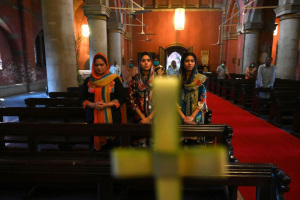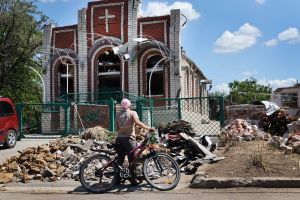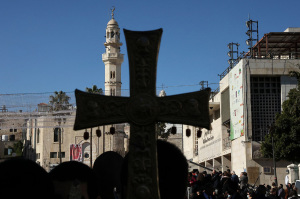God and Drug Cartels: Saving the Souls of Child Hitmen, Addicts
Monterrey – a city of 4 million, two and a half hours south of the U.S. border – is a Mexican financial and industrial powerhouse. It's also the place where the Zetas crime syndicate burned to death 52 innocent people in a casino fire last year to avenge the casino owner's refusal to pay them protection money.
The sounds of automatic weapons and grenade blasts disturb Monterrey's peace with distressing regularity as the Zetas battle rival crime groups for control of the drug trade and other lucrative criminal rackets in northeastern Mexico. The body count has exploded, with a killing being recorded for nearly every day of the year. Not long ago, Monterrey was considered the safest major metropolis in Latin America. Now, it's one of the most dangerous.
Pastor Andrew Garcia, 38, born and raised along the Mexican border in south Texas, felt a call from God in 2003 to preach the gospel in Monterrey. Since the violence began escalating there three to four years ago, his relatives and friends in Texas have been urging him to return to the U.S. before he gets killed.
"In Monterrey, people are murdered every day," Garcia, who pastors Voz Profética church, told The Christian Post. "I often hear gunfire and see dead bodies in the street. Every time we go somewhere, when we get back we give God the glory for keeping us safe.
"The violence hit real close to home when my wife Abby's uncle was murdered because he refused to cooperate with the Zetas."
At that point, Garcia said, he and Abby (who's from Monterrey) seriously considered relocating to Texas.
"But we prayed about it, and God gave us peace, so we're staying."
He said he's excited about what God is doing in response to the violence – so excited, in fact, that he isn't frightened and doesn't want to leave.
"I believe God has permitted all this to happen. In Mexico, the rich are really rich and the poor are really poor. The rich have always kept the poor down, and now they're paying the price. There's no way for the poor to get ahead. In some places, drug jobs are the only jobs. Cartels target the youth and offer them plenty of money."
The most popular cultural idols dominating Mexican movies, television and music, romanticize the narco lifestyle while depicting thugs as heroes. Young people who've known only poverty see working for the cartels as a golden opportunity. It's the only possible way to acquire fame, fortune, prestige, power and respect. It's the only way open to them to escape privation and live in huge fancy houses, drive huge fancy vehicles, wear huge fancy jewelry, and live huge fancy lives like the glamorous ricos they see swaggering and preening on Mexican T.V. and in the movies. Imitating the narco lifestyle has spread from Mexico and Latin America throughout the Hispanic communities of the U.S. and Canada.
The Mexican drug cartels focus on recruiting youngsters from eight to 17. The younger they are, the easier they are to control. They will do whatever they're told, no matter how vile. An eight- year-old was recently arrested (after carrying out four contract murders) on his way to commit a fifth. Another boy, 14, told of cutting up corpses and burning the pieces in an old oil drum. That was his only job, day in, day out. He stayed numb on alcohol and drugs to cope.
"The youth do it for the money. They don't realize all the evil they're going to have to do, like murders and beheadings, and when it starts getting bad, they start using more and more drugs to make it bearable. That gives Satan a foothold," Garcia said.
"But the more the violence and fear increases, the more people are coming to the Lord, the more cartel members are coming to church, and the more drug addicts are getting saved. Satan is using young people, but God is fighting back. In Monterrey, we're seeing a great move of God among the youth. They want more of God, they're hungry for Him. I've never seen a greater opportunity to reach the lost and advance the kingdom."
Garcia said that since the drug violence went through the roof over the last three to four years, he has seen a significant upsurge in salvations, healings, deliverances, miracles, church growth, unity between pastors and cooperation among churches, especially where unity and cooperation hadn't existed before. The church he planted three years ago in Monterrey has grown from eight to 80.
"Young people are interested in salvation and the word of God like never before. Our youth camps are packed and lots are getting saved. Drug addicts are getting saved. People coming out of drugs are more hungry, and the move of God is stronger in them.
"Not all churches are flowing in the Spirit. But the churches where the Spirit moves are bringing in a harvest of the lost youth. God is shedding his grace on the young people. He is definitely moving in Monterrey and throughout Mexico. I believe strongly that a mighty move of God is coming soon to Mexico, nationwide. It's going to be something amazing.
"I believe a great awakening is coming, the first ever for Mexico. There's never been a revival in Mexican history. There's so much idolatry and witchcraft, and a widespread worship of false saints like Santa Muerte ("Holy" Death) and Jesus Malverde – the two main patron saints of the cartels."
The cults centering around these so-called saints are hugely popular in Mexico, he said, and in some areas are preferred over the Catholic church. They are most prevalent in the nine Mexican states where the cartel violence is greatest, such as Nuevo Leon, in which Monterrey is located.
"Holy" Death, a statue of a skeleton garbed in a hooded robe and holding a scythe, is prayed to and given gifts to assure the prayers are answered. The greater the favor requested, the greater the gift required. For something really big, only human blood will do, and plenty of it.
Many of Mexico's most powerful drug lords worship Death and build giant shrines to "her." They say they love her and that she's at least as powerful as Jesus. She makes them stronger and more virile, they say, helps them succeed at whatever they do, can make them invisible, and protects them from bullets, which comes in handy in the midst of shootouts with rival gunslingers, or while fleeing from the federales and Mexican army troops.
Death's lovers set up altars to her in their homes, light candles before her statue and bring her fresh flowers, money, chocolates and other gifts. They say she eats whatever they give her and gives them whatever they ask for.
Jesus Malverde is a mythical being, who may or may not have existed. He's said to have been a Mexican Robin Hood who took from the rich and gave to the poor. His image is that of a handsome, dapper, mustachioed fellow who looks like a Mexican matinee idol from the 1940s.
Cartel bosses emulate Malverde by fleecing the rich – especially American druggies – and giving to the poorest of Mexico's poor by providing food, clothing, shelter, jobs and favors.
In return, the thugs are admired, loved and protected by the very people whose children they've lured into lives of addiction, criminality, self-loathing and death.
This article is the first in a four-part series on the effects of drug violence on Christianity along the Mexico-U.S. border





























